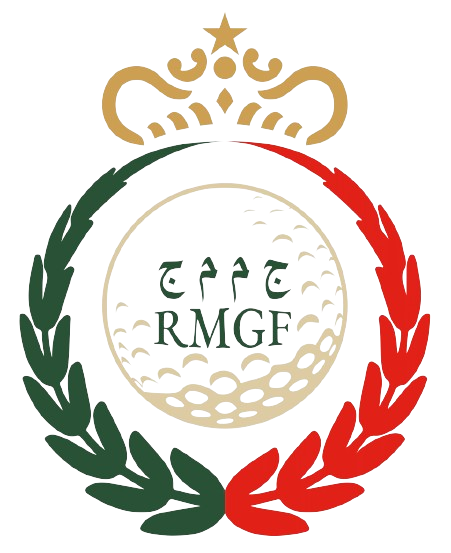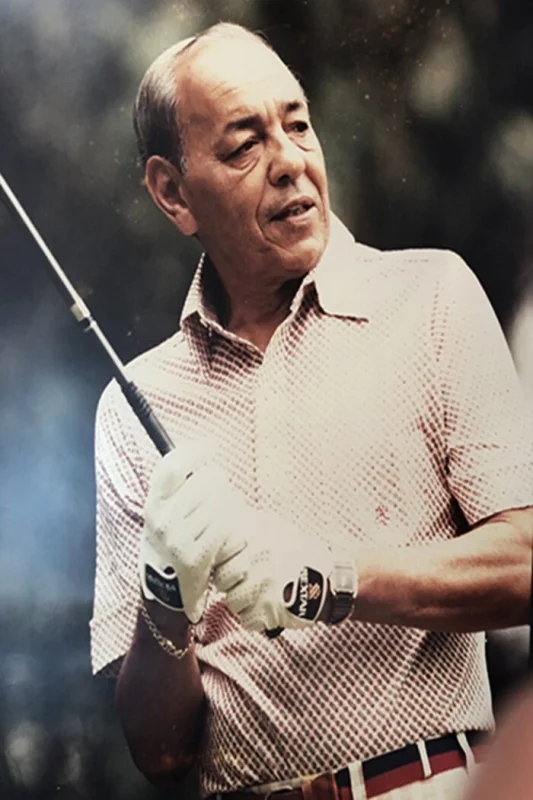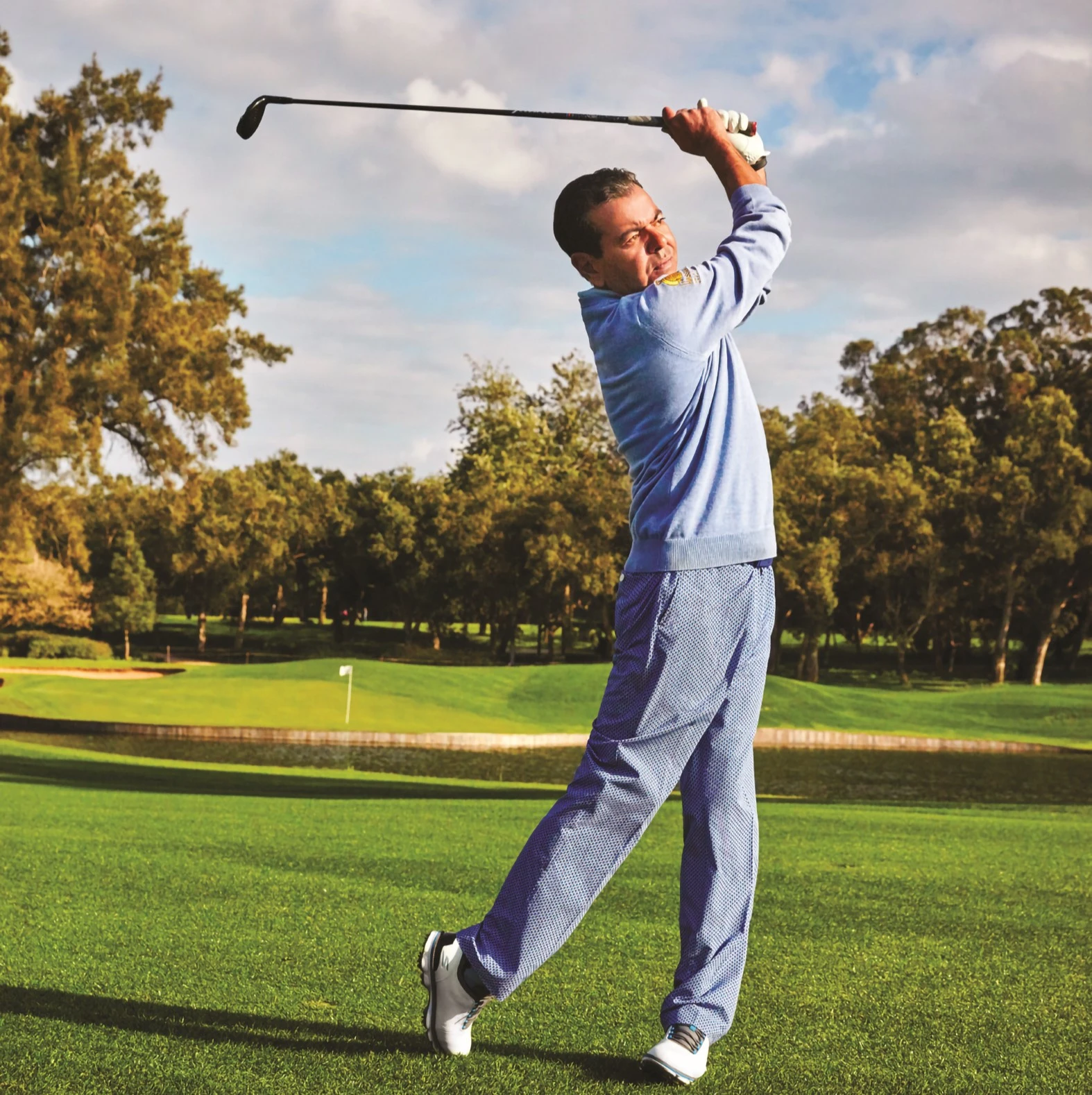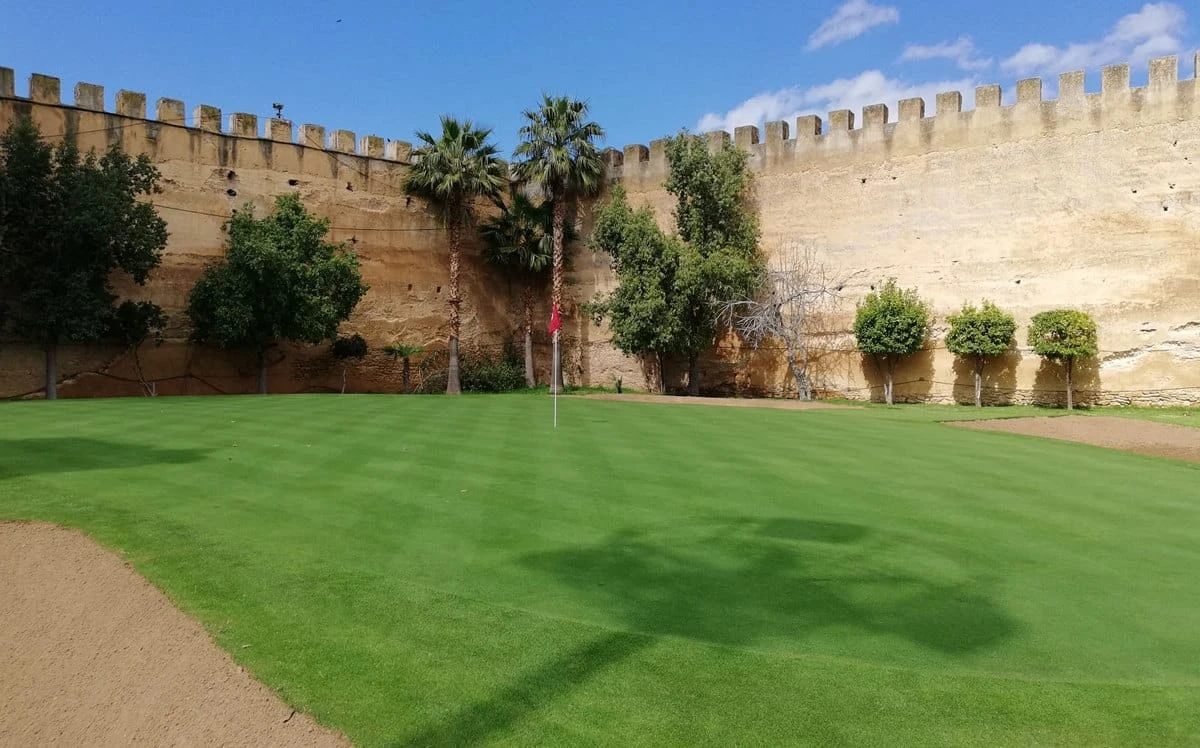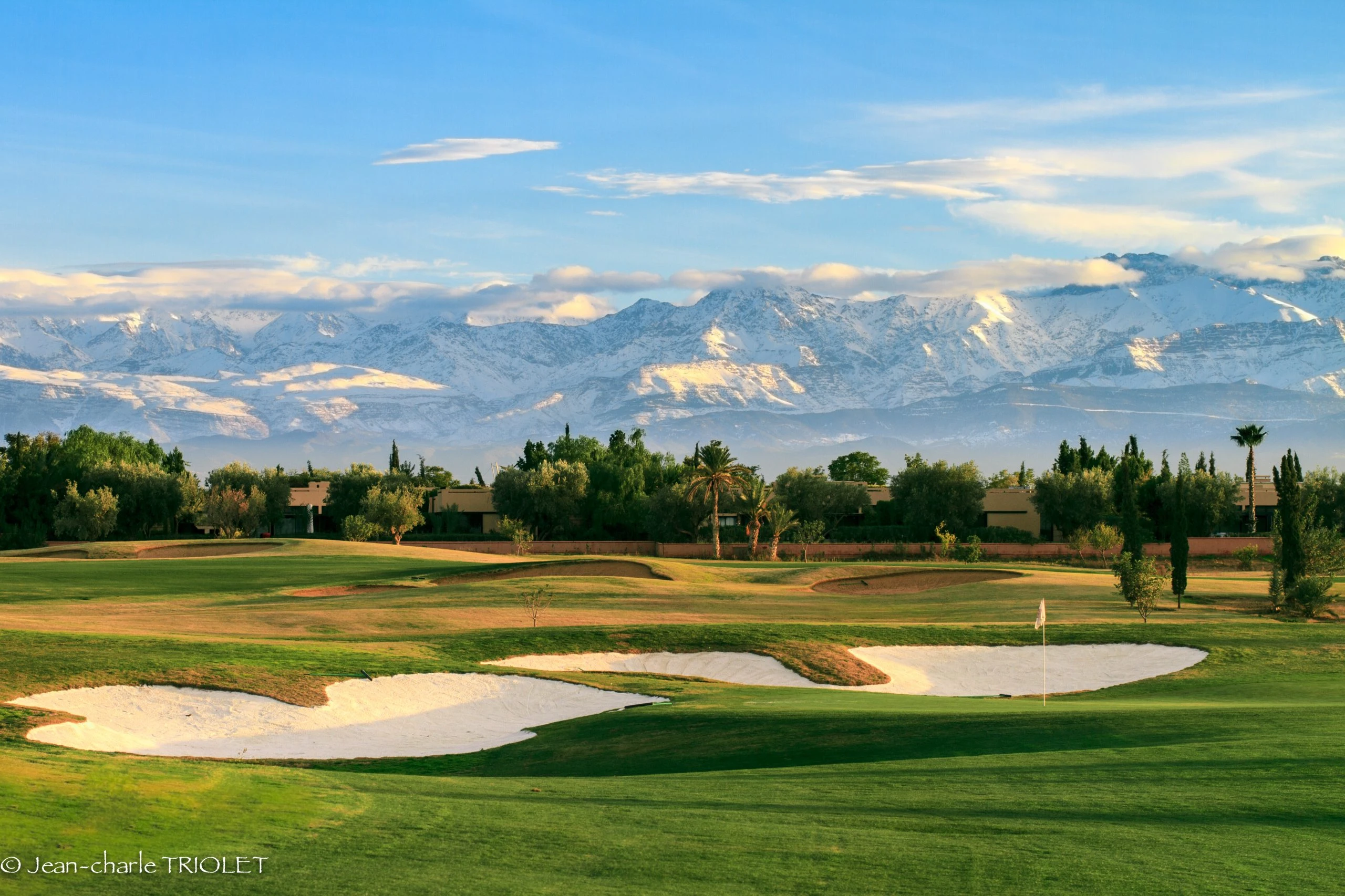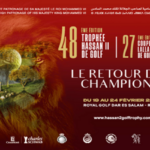Glossary
Ace
In golf, the ace is synonymous with a ball that goes straight into the hole in a single stroke from the tee. It's often a hole-in-one on a par 3.
All Square
This is an expression used in matchplay to describe a draw between two players. The score is determined hole by hole, and in the event of a tie at the end of the match, the term "all square" is used.
Albatros
It's a dream for golfers all over the world, including professional players. The albatross is a hole three shots under par (2 shots on a par 5, or a hole-in-one on a par 4). It's a rare feat on golf courses the world over.
Backspin
The backspin is that retro effect when a ball hits the green that makes all amateur golfers dream. Properly mastered, it gives you great ball control. The backspin effect is achieved through perfect ball touch, and is accentuated with more open clubs.
Golf ball
A small ball essential for golf. They are generally made of rubber or urethane and have a textured surface (nicknamed a honeycomb) to help improve aerodynamics. The ball is struck by the club, allowing it to roll across the golf course. There are several types of ball, depending on the level of play and the player's preferences.
Birdie
In the series of birdie names dear to the golfing lexicon, a birdie is a hole played one shot under par (3 shots on a par 4, for example). Easier to achieve than an eagle or albatross, it's not uncommon for amateur players to make one or more birdies in a round.
Bunker
These are sand obstacles strategically placed on a course to complicate the golfer's life! They can sometimes be very deep around the greens, and as a reminder, it's always forbidden to rest your club on the sand at address!
Chip
The chip is the putt made around the greens, with the aim of raising the ball slightly before rolling it towards the hole.
Golf Club
The tool used to hit a golf ball, it consists of a shaft (the handle), a head (the part with which the ball is hit) and a grip (the place where the hands rest) which can vary in shape and size depending on its specific use on the course. Players can carry several clubs in their golf bag, for different playing situations.
Comma
We often forget that in golf, a 300-meter shot or a 2-centimeter putt represents the same number of strokes on a scorecard. That's why a ball that changes trajectory only to emerge from the hole in a comma symbol can drive amateur and professional players alike mad...
Crossing
In this definition, we won't be talking about the long stretches of desert that golfers can sometimes experience in their game. Instead, we'll talk about an element that can get you out of those periods of doubt and frustration. Ball crossing is an essential element of the golf swing, and refers to the ball strike itself. For this to happen, you need to transfer your body weight from your right leg to your left, to generate a powerful and precise impact.
Core
The core is the central part of a golf ball. It can be made up of several parts to give it distance or accuracy, but it always has a core.
Divot
The divot (not the scrape) is the small piece of turf impacted by the club following ball impact, and often synonymous with good contact.
Driver
This is the golf club used mainly at the tee. It is the longest club and has the largest head. It enables the golfer to generate greater swing speed and maximize the distance covered by the ball.
Dog-Leg
The French translation of "dog-leg" is patte de chien. But what does this have to do with golf? Simply to describe a hole that is not straight, but turns to the left (dog-leg left) or to the right (dog-leg right).
Dropper
We're more used to hearing this term in rugby to define a ball falling to the ground before hitting it. In golf, dropping a ball means picking it up from an unplayable spot on the course and putting it back in playable condition. The method of dropping is simple: the player extends his arm to shoulder height before letting the ball drop to the ground with or without a penalty stroke (this is called a free-drop). If the ball is in the water obstacle, you perform the same operation, but with a ball from your bag !
Eagle
For the amateur golfer, it's often less unlikely than an albatross. An eagle is the term used to describe a hole two shots under par (3 shots on a par 5, for example).
Etiquette
In golf, etiquette is the set of practices, explicit or otherwise, that govern "living together" on a golf course. Often akin to the notion of respect for a shared space, a little reminder is sometimes in order!
Escalope
Attention ! Il ne faut surtout pas confondre l'escalope avec le divot ! Dans les deux cas il s'agit de la petite motte de terre engazonnée qui se soulève au moment de la frappe de balle. Mais dans le cas de l'escalope, c'est une zone arrachée avant la balle et non après. On parle dès-lors d'une balle « grattée », qui en générale parcours une très faible distance et correspond à un coup raté.
Eau fortuite
C'est une notion qui peut s'avérer particulièrement utile pour un joueur de golf. L'eau fortuite indique la présence sur le fairway ou le green d'une zone humide excessive, rendant la poursuite du jeu difficile ou impossible. Les règles de golf prévoient alors la possibilité de se replacer sans pénalité dans la zone la plus proche jouable et éviter ainsi des situations parfois périlleuses.
Fairway
Literally the "path of reason". The fairway is the ideal ball landing area after a tee shot. The turf is cut to the perfect height for a good second shot in the best conditions.
Fade
The fade is a ball effect which, when well executed, is not at all fade... the ball trajectory goes slightly from left to right for a right-handed player, or from right to left for a left-handed player. As the ball is "cut", it stops more easily on the green. The opposite effect (from right to left) is called draw, and enables the ball to be brushed to gain distance.
Fat-shot
The fat-shot (as opposed to the divot) is the divot torn off before contacting the ball and often the cause of a bad shot.
Fitting
Fitting is the set of techniques designed to improve your game. It's a way of adapting your golf equipment to your measurements (static fitting), but also to the way you swing or hit the ball (dynamic fitting). Using a computer dedicated to the operation, we observe a certain amount of statistical data to optimize your choice of clubs and shafts according to your style. Monsieur Golf's experts are equipped with state-of-the-art equipment to help you optimize your game, and their advice will be invaluable in fine-tuning your equipment choices.
Glove
The golf glove is much more than just an elegant piece of golf clothing. Generally intended for the left hand of a right-handed golfer and the right hand of a left-handed golfer, the glove provides an optimum connection between the hand and the grip of your club. Most professional and amateur players use a glove to get a better grip on the club. Depending on the player, the glove can be made of leather for a better feel, or of synthetic material for a longer lifespan, especially for players with nervous thumbs!
Golf hybrids
This is the most versatile golf club, usable on virtually any surface on a golf course. They combine the characteristics of a fairway wood and an iron. They are used to get out of difficult conditions, such as the rough (the area with the highest grass on the course).
Green
This is simply the name given to the shortest grassy area of the course. Located around the hole, it requires you to roll the ball, often using your putter. Please note: this is grass, not carpet!
Grip
This is the generic term for the way you hold your golf club, as well as the area where you place your hands. Often made of rubber, the grip evolves over time and becomes customizable, or can be produced in different materials (silicone, leather, etc.).
Golf
Since you practice it, you have a pretty good idea of the definition of the word golf! Nevertheless, you should know that golf exists in its contemporary form, thanks to the rules laid down by the Scots in a compendium produced on the site of Saint Andrews. Some people also like to give meaning to the word golf by means of the following acronym: Gentlemen only, ladies forbidden, which has fortunately evolved over time ...
Golf iron set
A set of golf clubs with different numbers 1 to 9. They feature different lofts (clubface angles), enabling golfers to select the right club for each shot according to distance and obstacles on the course.
Hook
This is a ball effect, this time rather involuntary, which propels the ball sharply to the left (for a right-handed player) when it was originally heading for the target. The opposite effect is well known to the average golfer, and is called slice.
Handicap
The handicap is intended to define the level of an amateur player. It often represents the average number of shots a player makes in relation to the total par of a course. As this figure is a weighted average, it is also available with a decimal point, known as the index.
Hosel
Not necessarily the term most people use when they're golfers. Nevertheless, for lovers of technique and equipment, it can be a great way to shine at social events. The hosel is simply the point where the clubhead is attached to the shaft. A point that is particularly stressed at the moment of ball impact.
Hole
For all of us, the hole is the ultimate quest for the grail of golf: the place we want to reach with the fewest possible strokes. But to better master this famous hole, it's important to know more about it. A golf hole is circular in shape, with a diameter of 10 cm. When the flag is positioned inside the hole, there's just enough space for a ball to enter - to the nearest millimetre!
Index
You already know the handicap, the number that corresponds to your level of play. The index is a complementary element to the handicap, making it possible to refine a golfer's real ranking even further. The index is the decimal number used to establish the weighted average of a player's scores, and thus define his or her level of play down to the decimal point.
Interlocking (grip)
This is a way of holding your club, under the generic term of grip. Grip interlocking means that the little finger of the right hand is wedged between the index and middle fingers of the left hand, giving you a firmer grip on your club.
Insert
The insert is a synthetic material that gives putters a harder or softer feel at impact. In addition to the feel, the insert can give the ball a more or less dynamic roll after impact.
Impact
This is the sweetspot where the ball makes contact with the club. The ideal zone is called the sweetspot. Over an entire course, the time the ball remains in contact with the club is no more than one second...
Incidental water
This is a particularly useful concept for golfers. Incidental water indicates the presence of an excessively wet area on the fairway or green, making continued play difficult or impossible. The rules of golf allow you to reposition yourself without penalty to the nearest playable area, thus avoiding sometimes perilous situations.
Joke
A game of golf is a time for sharing between friends or opponents on an 18-hole course. A moment that can last a long time, and where complicity between players is often the order of the day. As a result, jokes and bon mots can fly like bullets, and it's not uncommon for the term "joke" to indicate that you're being gently mocked, but always in the second degree!
Jouable
Par définition, une balle de golf peut être jouable sur toute partie du parcours, dans les limites du terrain. Néanmoins, dans certaines situations (balle collée à un arbre par exemple) la balle peut être difficile voire impossible à jouer. Dès-lors, le golfeur peut la déclarer injouable et la replacer sur le parcours avec un coup de pénalité.
Kick
Kick is the term used to describe the bounce of a ball. Sometimes we're lucky enough to have a good kick that brings us back on the green, but often the golfer only remembers his bad kicks.
Kolven
When you look at the definition of the word golf, you immediately find ramifications in Scotland and the British Isles. However, Holland also lays claim to this game, which was used to keep shepherds occupied during their transhumance. This game, which used all the surfaces recognized today by the game of golf (bunker, water obstacle, etc.), was called Kolven, a term that sounds like the word golf.
Lip
There are two types of lip in golf. The lip of a hole defines the edge between the ground and the hole. So it's not unusual to be able to taste the hole with the tip of your lips, but never actually fall in! In fact, it's often easier to fall into a bunker, whose various edges are also called lips. But in this situation, it's often less complex to kiss the lips of a bunker on a missed shot!
Lie
First and foremost, the lie is where the ball rests on the course. In purely technical terms, the lie also determines the angle of the sole of the club in relation to the ground at the moment of ball impact. During a fitting session, the lie is a decisive factor.
Links
Each golf course has its own specific features and technical characteristics that make it unique. But there are some common features to the courses originally created in the British Isles. The term Links is used to describe seaside courses, generally treeless and regularly swept by the wind and sea spray. It's a course that gives pride of place to the surrounding nature, and is often complex to play. But links remains the grail for any good golfer who wants to know the origins of the game.
Loft
The loft of a golf club is the degree of openness of its face. It obviously varies from club to club, and can also be adapted to each golfer's ability (or lack of it) to generate high ball trajectories. The smaller the club number, the lower the loft.
Match-play
Match-play is a possible form of golf. Instead of competing on the course before comparing the scores of all the players, match-play is a head-to-head game. The aim is to beat your opponent hole by hole, in a kind of modern-day duel! Whoever wins the most holes wins the match.
(Ball)marker
When players arrive on the green, it's time to roll the ball into the hole. But sometimes, an opponent's ball may be in the theoretical path of your own. To avoid any problems, a ball marker (also known as a "chip") is used to locate the ball without disturbing your opponent.
Mulligan
That's the kind of term you're going to love! Although you'll only be able to use it when playing with friends. A mulligan is a free move that gives a player a second chance on his or her first move.
Net
To enable amateur players to shine in competition, whatever their level, there are two types of ranking. The gross ranking brings together all the scores achieved by the field of players. The net ranking, on the other hand, takes account of the player's handicap to smooth out differences in level, and establish a more homogeneous classification of the day's performances.
Nibblick
It's an old-fashioned term, but one that can make you shine in society! Nibblick is simply the old name for the 8 or 9 iron in a golf bag.
Obstacle
The generic term "obstacle" is used to describe any place on a course where the ball is outside the "logical" path. Water, rough, bunkers and woods are classic examples of obstacles.
Removable obstruction
Removable obstructions are all objects not attached to the ground that may come into contact with the ball, preventing you from playing it properly. These obstructions can take the form of dead leaves, twigs or stones, among others. These obstructions can be cleaned or removed without penalty, as long as they do not cause the ball to move.
Offset
This is the slight offset (forward) between the shaft and the clubhead. Offset gives extra ease of play, particularly when lifting the ball and reducing slice.
Overswing
Overswing is an exaggerated or even oversized rotation of the upper body during the golf swing. Unless you're very flexible, this phenomenon causes the elbow to break at the top of the swing, adding power at the expense of ball control. Properly mastered, this can be a real asset, as John Daly, a professional golfer, has made his trademark.
Out of bounds
Out-of-bounds refers to areas outside the playing area of a golf hole. In general, it takes a serious departure from the playing line to reach these remote areas, which are marked by white lines and stakes. An out-of-bounds ball will force the player to replay a ball from its point of origin, with a penalty stroke.
Par
This is the theoretical score the player must achieve by adding up all 18 holes to make a perfect result. On each course there are Par 3s (less than 229 meters), Par 4s (between 228 and 434 meters) and Par 5s (over 434 meters).
Pinching the ball
Pinching the ball is an expression used to describe an ideal shot. A perfect shot is generally one in which you first hit the ball, then the ground (ball-to-ground), allowing the clubface to give the ball maximum rotation. In this case, the backspin effect appears naturally on contact with the green.
Penalty
Sometimes you have to talk about the things that make you angry! A penalty is, as the name suggests, an additional stroke that a player must add to his or her score for failing to comply with the rules of golf. In certain situations, players can even be penalized with two strokes. To avoid problems, it's a good idea to carry a rule book in your bag at all times, so you can prevent any situation from arising.
Putter
This is the golf club used to hit the ball over short distances, mainly on the green (the mown surface of the course where the flag is located). The golf putter has two head shapes, nicknamed "mallet" and "blade". As a rule, it's the last club used to drive the ball into the hole.
Pitch
The point at which a ball hits the green. It's a particularly gratifying little mark, since it's often synonymous with a perfectly executed shot. For the respect of other players and the green, the pitch-relief allows you to return the ground to the state it was in before your shot.
Playable
By definition, a golf ball can be played on any part of the course, within the limits of the terrain. However, in certain situations (e.g. a ball stuck in a tree), the ball may be difficult or impossible to play. In such cases, the golfer can declare the ball unplayable and replace it on the course with a penalty stroke.
Rough
The rough is an area of tall grass outside the fairway. This area can vary in height and density, making it difficult for a player to hit the ball properly if he gets lost.
Rules of golf
Golf is a game in which the aim is to hit a ball on an 18-hole course with as few strokes as possible. But between theory and practice, there are many, many situations to complicate this simple game philosophy. The rules of golf were laid down by St Andrews, the birthplace of the game, and are regularly revised to keep pace with developments in the game and in equipment.
Regulation
A term applied to the arrival of a ball on a green within the required number of strokes. It's a statistic that measures the efficiency and precision of a player's iron play. To reach the green in regulation, you need to take into account the score of the hole, from which you need to subtract two strokes, corresponding to the two theoretical putts to be made (e.g. arriving in two strokes on the green of a par 4).
Recovery
It's a particularly risky golf shot, but when it's successful it often stays in the player's memory for a long time! Recovery is the shot between two trees, or from a particularly dense rough, that enables the player to find the right path, and sometimes even the green.
Sand-wedge
This is the name given specifically to the club that enables you to get out of complex situations. In long, thick grass or deep bunkers, it's important to get the ball up quickly to avoid blocking. This is why the sand-wedge is a 56-degree open club, to naturally give height at the expense of distance.
Shoot
It's not a term designed purely for golf, but when you've made a bad shot it's easy for a player to express his frustration with a few bird names. A good "zut" is just as effective, and so much nicer to hear for your playing partners... remember the etiquette!
Shaft
This is the technical term for the shaft of a club. Not to be overlooked when choosing your equipment, as the shaft is the club's engine. So be careful not to buy a Formula 1 when you've barely mastered a golf cart!
Slice
Probably the easiest effect for the amateur to produce, the slice is often an undesirable one. It refers to a missed shot that causes the ball to curve excessively to the right. Slice is often produced by a delay in the hands at the moment of ball impact, but can also be useful in certain situations where the ball needs to be turned quickly to get around a tree, for example.
Socket
The missed shot par excellence! A socket is a ball hit with the bottom of the shaft (not the clubface), resulting in a shot that goes off at 90 degrees. To console themselves, amateur golfers like to know that between a perfect shot and a socket there are only a few millimetres in the impact zone... but they make all the difference!
String
The term "string " is used twice in golf. It can be used to define a form of play, the string stroke, in which the player benefits from a length of string equivalent to his or her level in order to reduce the distance of a shot. But the term "string" is also used to describe a long putt hit from the other end of the green. In general, the player feels that his shot is particularly successful and can be congratulated by his playing partners with a friendly "Nice Putt!" uttered as the ball enters the hole, as if remote-controlled by the gods of this game!
Tee
Well-known to crossword puzzle fans, the tee is the little mound that raises the ball on the first shot of a hole. There are a thousand and one tee shapes, made of wood or plastic, stepped or not, etc. It's up to you to find the one that suits you best!
Topspin
Once again, this is a particularly useful ball effect that generates greater ball rotation. As a result, the ball gains in roll and distance. If you hit the ball on the skull, you'd be talking about a "topped" ball, which is far less effective...
Upright
During your training sessions with a pro, this term may come up again and again. It defines a vertical swing plane and, when properly mastered, can prove to be an additional asset in your game, depending on the circumstances.
Utility Wood
With the advent of hybrid clubs, the amateur golfer has tended to shelve the 5- and 7-woods that used to be great tools. These clubs, with their wide soles, enable you to get out of the trickiest situations by generating ball roll. Unlike the hybrid, which has a high trajectory, the utility wood produces tighter trajectories, making it interesting in windy conditions.
Vardon
This is one of the grip techniques popularized by Harry Vardon (a player in the early 20th century). Today, it's the most widely used grip in the world.
Waggle
The term "waggle" refers to all the small, individual movements that trigger the swing mechanics. For some, these are small hand movements, for others more like pelvic or hip movements.
Wedge
We're all familiar with the sand wedge. The wedge, however, is a generic term used to describe all very open clubs, designed to facilitate approach shots to the green. The aim is to create a high trajectory for the ball to stop more quickly around the hole. Sand-wedge is the specific wedge for bunker exits, but there are also other names depending on the degree of openness, such as the Lob Wedge, open at 60°.
Woods
These are clubs designed to provide distance and roll to the ball. Wood can be used on tee shots, but also on the fairway (the part of the course between the tee and the green). The second-longest club in the bag, it can be played on a second or third shot on a longer hole. These clubs were originally made of wood, and were fitted with a sock to protect them from variations in temperature and humidity.
Yard
Like everyone else, golfers are always keen to discover new courses abroad. While in France distances are expressed in meters, outside our borders (particularly in Anglo-Saxon countries) it's the yard that remains the standard. One yard is equivalent to 91 cm (deduct 10% for easier calculation).

